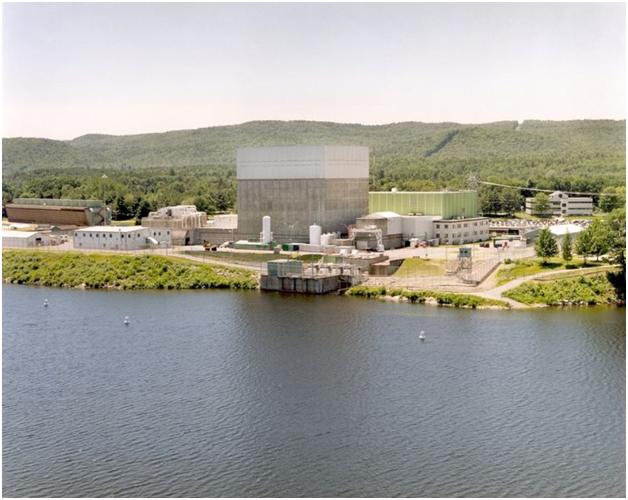The Vermont Yankee Nuclear Power Plant is located in Vernon, Vermont. It has a six hundred and twenty megawatt General Electric boiling water reactor that draws cooling water from the reservoir pool of the Vernon Hydroelectric Dam on the Connecticut River. It was put into operation in 1972 and was licensed for forty years until 2012. Entergy Nuclear currently owns and operates the power plant.
Vermont Yankee was built by a group of big utility companies. In 2001, the utilities tried to sell Vermont Yankee to AmerGen for sixty one million dollars but the Vermont’s Public Service Board said that an auction was necessary if they wanted to sell the power plant. In 2002, the utilities sold the plant to Entergy Nuclear for one hundred and eighty million dollars. Entergy and Vermont agreed that they would abide by the decision of Vermont’s Public Service Board on the question of whether Vermont Yankee should continue to operate after their original license ran out in 2012. In 2006, the Vermont legislature passed a law that required the Public Service Board to obtain the approval of the legislature before considering the extension of the plant’s license past the expiration of the original license.
The population in the plume exposure pathway zone with a radius of 10 miles around the plant is about thirty five thousand people. The population in the ingestion pathway zone with a radius of fifty miles around the plant is about one million five hundred and forty thousand people. The risk of a seismic event that could threaten the plant is rated as very low.
In 2007, part of the west cooling tower collapsed due to corrosion in steel bolts and rotting lumber. Non-radioactive water was spilled into the environment. The NRC review of the accident said that they considered this to be an industrial accident that did not pose a threat to the reactor. A Vermont study concluded that Vermont Yankee was being operated in a safe manner and did not pose a public threat.
In May 2009, the special oversight committee appointed by the Vermont legislature heard testimony from plant operators that there was no radioactive contamination of ground water from leaking underground pipes. However, in October of 2009, it was confirmed that there really was radioactive contamination leaking from underground pipes at the plant. Entergy was accused of making misleading statements and was told that they would be liable for some legal expenses relating to the leak.
By 2010, the level of radioactive tritium in ground water around the plant had risen above the federal limit for safe levels and ultimately reached one hundred times the limit for safe drinking water. Eventually, the leaks were traced to a pair of steam pipes in a pipe tunnel and the leaking pipes were repaired. Later in 2010, a water leak caused by a faulty weld caused a short shut down of the plant for repairs.
In 2011, more tritium was detected in ground water but the source has not yet been identified.
In early 2010, the Vermont legislature voted to instruct the Vermont Public Service Board to reject the request of a license extension of Vermont Yankee beyond 2012. The NRC ultimately issued the license extension in 2011. Entergy sued the state of Vermont to overturn the ban of a license extension passed by the state legislature. In 2012, the U.S District Court ruled that Vermont did not have the authority to deny the new license and that such matters were the exclusive province of the NRC.
Vermont Yankee had design problems that led to serious leaks of tritium and the owners lied about the leaks. The state of Vermont tried to prevent the plant from continuing to operate but the U.S. District Court said that they did not have the right to shut down a nuclear power plant in their state that they considered to be a danger to their citizens.
